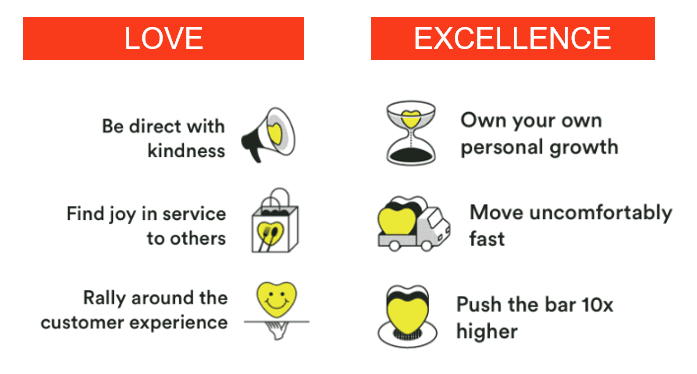This piece is part of our series on sessions presented at Compference19. You can register or learn more about Compference20 here.
Highlights from Compference19 Session: The Heart of a Company: Building with Authenticity, Transparency, and Vulnerability with Joe Bast, VP of People at Chewse
At Compference19, Joe Bast, VP of People at Chewse, led a session on the value of salary transparency in building a company culture. Chewse is a business catering company that emphasizes being an authentic and diverse company. Its mission is to make sure everyone has a seat at the table.
Chewse wanted to get to its clients through the values of authenticity and connectivity and realized that it had to be authentic and connective itself first. The company came up with six values under the umbrellas of love and excellence, including “be direct with kindness” and “own your own personal growth.” Pay transparency has been a critical component of the company’s approach to its values and an intrinsic part of the company’s culture.

Chewse adventured into salary transparency when the company had around 100 employees. In 2019, it quadrupled in size and plans to quadruple again in 2020. At the current run rate, the trajectory in 2020 is to grow to a 1,500 to 2,000-person company. Chewse plans to remain committed to salary transparency and exemplify what a culture of authenticity, vulnerability and transparency looks like at scale.
Here’s how they do it:
Salary Transparency is Nothing to Fear
Most people are fearful when it comes to salary transparency. You grow up being told not to talk about how much you make, so when you get a job, you don’t know how to have a conversation about salary. The subject of salary transparency has been a taboo until relatively recently.
In addition, salary transparency can be risky to a business. Management worries about the ricochet effect of pointing out pay inequities and how other employees will see their managers and peers if salaries are common knowledge. There might be a negative impact on morale, causing dissonance, lack of engagement, and increased employee turnover. Worse yet is the fear that salary transparency could cause the company to discover it has a fairness problem, which can have legal ramifications. Finally, there is the question of whether money really makes people happier and if too much emphasis on compensation sends the wrong message about what people should be working for, especially in culture-first organizations looking to attract people who are passionate about the company mission.
If you can’t assuage any of these concerns with certainty, doesn’t that mean that the risk inherent in pay transparency is too great?
Well, not exactly.
These fears are largely myths.
The Truth About the Impact of Salary Transparency
Research on salary comparisons from the National Bureau of Economic Research published in the Harvard Business Review shows that people tend to work harder when they learn what their managers earn. They spend 4.3 percent more hours in the office, send 1.85 percent more emails, and sell 4.4 more, especially if they are only a few steps below their manager and may — with effort and a little luck — occupy their manager’s position someday. In this circumstance, the differences in salary between managers and employees is actually incentivizing.
As for pay inequities between peers, the same research shows that employees are demotivated by finding out their coworkers are earning more than they had guessed, especially if their guess was off by more than 10 percent. These employees spend 9.4 percent fewer hours in the office, send 4.3 percent fewer emails and sell 7.3 percent less.
However, this isn’t particularly surprising and doesn’t constitute a dismissal of salary transparency.
What this research indicates is that pay needs to be fair and accurate and employees need visibility into why they make what they make and how to grow. People are unhappy when they don’t know how they are being valued compared to other employees in the same position. People don’t expect everyone in an organization to be paid exactly the same. However, they do expect pay to be fair and well-supported by research and data.
When pay equity is not systemized and pay policies are not well-communicated, it leaves the door open for employees to assume other factors are at play, such as unconscious bias, salary compression, playing favorites or discrimination. These perceptions are what lead to employee disengagement and turnover.
For salary transparency to work, compensation must be fair. In order to be fair, compensation must be data-driven.
Chewse has an extremely transparent pay policy based on salary benchmark data and a well-communicated pay strategy that starts with the first phone call of the hiring process. The recruiter asks about salary expectations right off the bat and the company has a no negotiation policy when it comes to pay. People who try to withhold or negotiate during the hiring process will have the pay policy explained to them. If they can’t accept it, they are not a good fit for Chewse. Because salaries are fair for everyone and based on data, salary negotiation is unnecessary. There is no curtain to hide behind. A female senior software engineer with eleven years of experience at Chewse makes the same as a male senior software engineer with the same experience. Whether an employee has a family, a long commute, or some other personal, non-compensable factor makes no difference to compensation.
Chewse is the ideal situation, but the ideal is attainable. Most companies that are afraid of salary transparency are afraid because have fairness problems. Those problems continue to exist without transparency. They just fester beneath the surface, and they can lead to losing top talent.
Navigating Pay Inequity with Salary Data and Communicating Career Progression
When it comes to determining whether they are paid fairly, employees tend to look at the best cases, such as going to Glassdoor and trusting that the self-reported salaries there are indicative of what everyone in their position is earning except for them. Internally, people are prone to listen to rumors. They may get wind of employees being actively and purposely underpaid or hearing of someone who got a significant bump in salary by going to a competitor. In other words, when salaries aren’t transparent, people tend to believe they are underpaid, even when they are compensated above market.
Salary transparency isn’t the problem here. Salary transparency is the solution.
It is important to understand that salary transparency doesn’t mean publishing what everyone earns. The degree of transparency required can vary between organizations according to the pay transparency spectrum. Salary transparency really just means having open access to information. This means having a pay philosophy and communicating that philosophy. It means using benchmark data, such as from PayScale, to formulate salary bands and pay grades. It’s about calculating all compensable factors — years of experience, location, skills, etc. — and communicating the organization’s compensation plan. Ideally, it’s about providing employees with a total compensation statement that explains where they fall in their job’s range.
What also matters is communicating what people have to do to grow in their career to earn more. When people understand what they have to do to make more money and why, they will work for it. They will become more engaged, more skilled, and more productive.
For example, Chewse had someone in an IT helpdesk manager role express a desire to become a product manager because the compensation for that position was nearly double what they currently made. Great. Chewse explained to that person what they needed to do to get that job. In this case, it was a course and a certificate. That person earned those credentials and then applied for the position they wanted and got it. Without salary transparency, the pathway to greater personal success would not have been apparent. With salary transparency and support for employee advancement, you can change someone’s life. Incidentally, you will also level up the value your employees bring to your business.
Of course, you might also have people realize that they don’t really want a position they thought they did. Perhaps the money is all that was attractive about it. This is where job descriptions are critical. With clear communication about how salaries align to expectations, an individual might realize that someone in a management position who makes more than they do is also spending more time at the office, more time on the road, more time in high pressure situations, and so on. That individual may not want to take on those things once they understand what it entails.
Being transparent about salary squashes rumors. People don’t need rumors because they have direct access to information. Regularly communicating about salary as a function of the job and the expected levels of performance will head off all kinds of frustration that an individual might feel otherwise.
Salary Transparency and Performance Based Evaluation in Action
Salary transparency doesn’t mean that all salaries have to be equal or that high producers can’t be incentivized and rewarded. The solution is rewarding employees for performance and setting clear expectations around how compensation levels map to expected outputs.
Chewse tackles performance-based pay through a custom system that ties letter ratings to experience and output levels. Employees come in at a letter level commiserate with their experience and have regular reviews every 90 days to discuss their output and what they have to do to get to the next level. Chewse uses PayScale salary market data to map output levels to role percentiles, factoring in geography and other compensable factors and documenting the corresponding salaries in a spreadsheet that is made available to the whole company.

The A-G letter grade structure covers the whole scale for output. An “A” is someone right out of school. If they have experience, they get a 1.1 multiplier. “C” is equivalent to 50 percent output. A “D” is someone with enough experience to produce immediately without much coaching. An “E” has broadened skills and also contributes to building networks and evangelizing the company brand. Getting from “E” to “F” is difficult. A “G” is someone who is industry-renowned. For example, they may have produced and patented a product that differentiates the company in the market or something of similar significance.
Every job advertisement includes a salary range from output levels A-D. During the interview process, people are educated about where they fall in that range, how the range is determined using PayScale compensation market data, and the process for advancement. Hiring managers make the offer rather than the recruiter, setting the precedent for ongoing future conversations about compensation and outputs every 90 days.
One of the benefits of this process is that it fosters leaders at every level of the organization. Everyone learns to have tough conversations and to have them regularly. Most companies fail to train managers on how to talk about compensation at all. Everyone is uncomfortable with it, leading to a culture of avoidance and a tendency for managers to foist the responsibility onto HR.
At Chewse, everyone is an expert in compensation and performance. Managers learn how to be direct, instructive and caring. They learn how to listen and set clear expectations. When disagreements arise, managers know how to address conflict quickly and prevent escalation. As coaches, managers learn how to be motivating and challenging, helping direct reports to become their best. The result is company-wide growth.

The Results of Pay Transparency and Performance Based Evaluation
Chewse is seeing remarkable results with their approach to salary transparency. EEOC and ACA compliance is simple and straightforward, but more importantly, recent survey results show that more than 80 percent of fulltime workers are satisfied or very satisfied with their career at Chewse. The company also boasts a low employee turnover rate, with some teams experiencing less than 10 percent turnover. In addition, there are examples of exceptional levels of cross-departmental career moves, with more than 50 percent of employees having worked in more than two roles, departments or teams. Employee performance reviews are completed at a rate of over 90 percent.
In summary, salary transparency has enormous benefits on employee satisfaction and advancement, which contributes to rapid company growth. However, salary transparency must be fully embraced as an intrinsic part of the culture and supported with strong compensation data, communication, and training.



